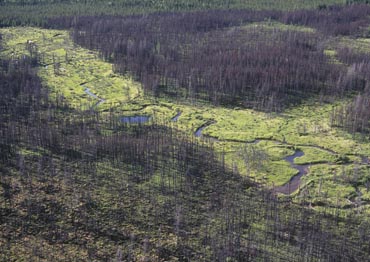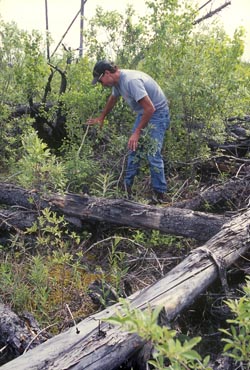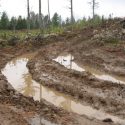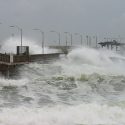Wildfire drives carbon levels in northern forests
Far removed from streams of gas-thirsty cars and pollution-belching factories lies another key player in global climate change. Circling the northern hemisphere, the conifer-dominated boreal forests — one of the largest ecosystems on earth — act as a vast natural regulator of atmospheric carbon levels.

An aerial view reveals the extent of a 2003 fire in the boreal forest of Manitoba, Canada. UW–Madison forest ecologist Tom Gower has found that fires are the leading environmental factor driving the balance of carbon dioxide uptake and release in these forests.
Photo: Wolfgang Hoffmann
Forest ecologists at the UW–Madison are studying how environmental factors such as forest fires and climate influence carbon levels in this forest system. Their most recent findings, reported in the Nov. 1 issue of the journal Nature, offer insight into the balance of carbon uptake and release that contribute to atmospheric carbon dioxide levels worldwide.
Second in size among forests only to the tropical rainforests, the boreal forests form a massive green band spanning the higher latitudes of Canada, Alaska, Siberia, China, and Scandinavia. Their sheer size, coupled with the fact that they are expected to experience the greatest warming of any forest biome as global temperatures rise, means that climate-related changes here are likely to resonate well beyond the forest boundaries, says S. Tom Gower, UW–Madison professor of forest ecology and management and primary investigator of the project.
In the new study, Gower and his colleagues used a computer model to simulate the carbon balance of one million square kilometers of the Canadian forest over the past 60 years, to determine the relative impacts of climate and disturbance by wildfire.
The group found that the effects of carbon dioxide and climate — temperature and precipitation — varied from year to year but generally balanced out over time and area. Instead, forest fires during the 60-year period had the greatest direct impact on carbon emissions from the system.
However, "because fire frequency and fire intensity are directly controlled by climate change, it doesn’t mean that we shouldn’t be focusing on climate change," Gower says. "Climate change is what’s causing the fire changes. They’re very tightly coupled systems."

Tom Gower, a forest ecology and management professor, examines the site of a 1989 burn in Canada’s boreal forest.
Photo: Wolfgang Hoffmann
The researchers believe that fires shift the carbon balance in multiple ways. Burning organic matter quickly releases large amounts of carbon dioxide. After a fire, loss of the forest canopy can allow more sun to reach and warm the ground, which may speed decomposition and carbon dioxide emission from the soil. If the soil warms enough to melt underlying permafrost, even more stored carbon may be unleashed.
A trend toward hotter and drier conditions is likely to exacerbate the effects of fire by increasing the frequency, intensity, and size of burns. "All it takes is a low snowpack year and a dry summer," Gower says. "With a few lightning strikes, it’s a tinderbox."
Historically, scientists believe the boreal forest has acted as a carbon sink, absorbing more atmospheric carbon dioxide than it releases, Gower says. Their model now suggests that, over recent decades, the forest has become a smaller sink and may actually be shifting toward becoming a carbon source.
"The soil is the major source, the plants are the major sink, and how those two interplay over the life of a stand really determines whether the boreal forest is a sink or a source of carbon," he says.
Though the model is not currently designed to forecast future conditions, Gower says, "Based on our current understanding, fire was a more important driver (of the carbon balance) than climate was in the last 50 years. But if carbon dioxide concentration really doubles in the next 50 years and the temperature increases 4 to 8 degrees Celsius, all bets may be off."
Other scientists involved in the research are Ben Bond-Lamberty, Scott Peckham, and Douglas Ahl. Funding for the work was provided by the National Science Foundation and the National Aeronautics and Space Administration.
Tags: climate change, international, research



